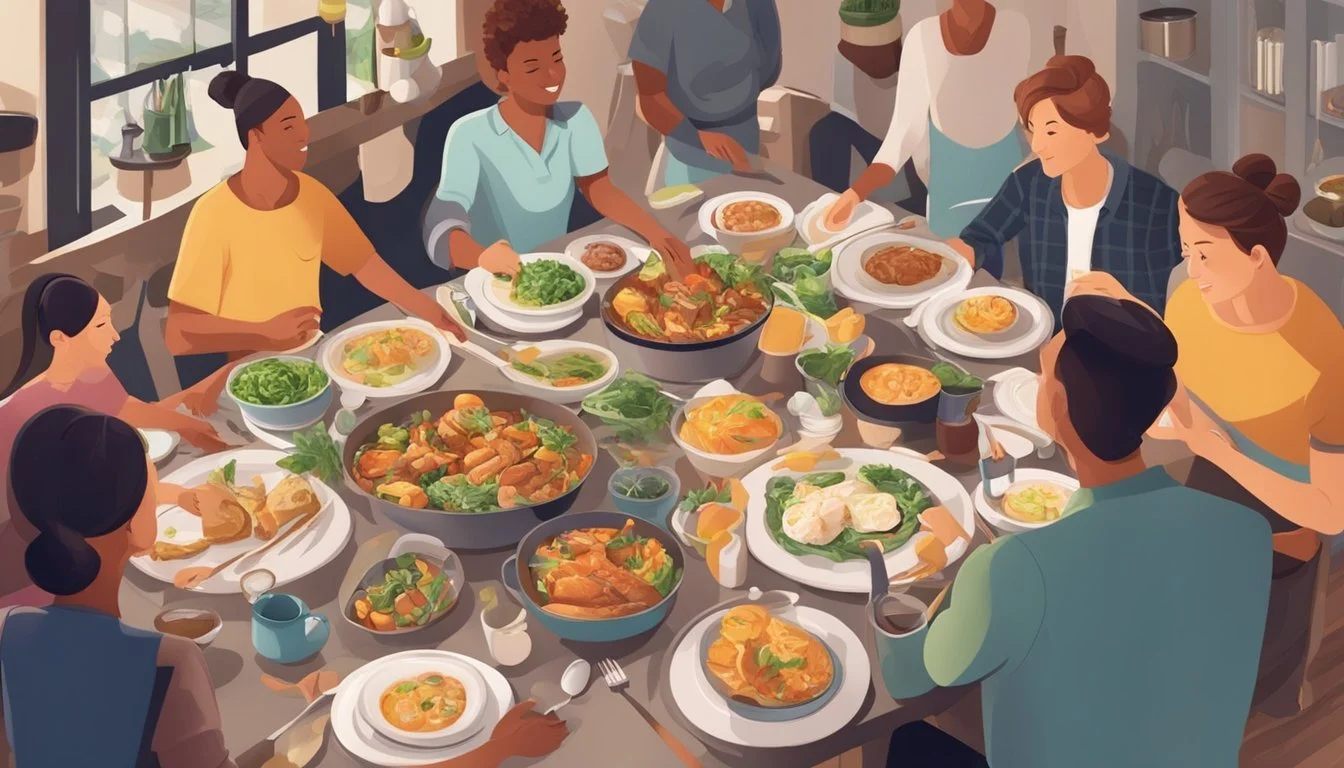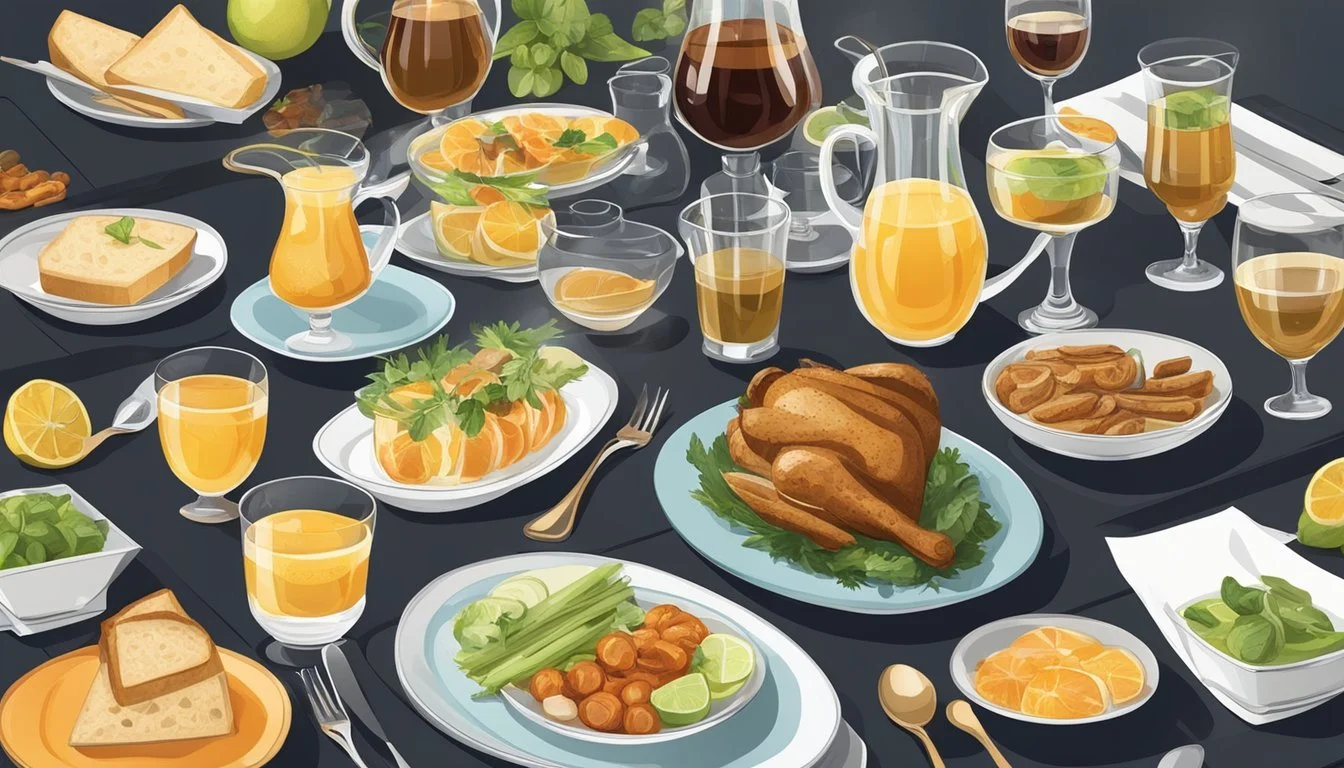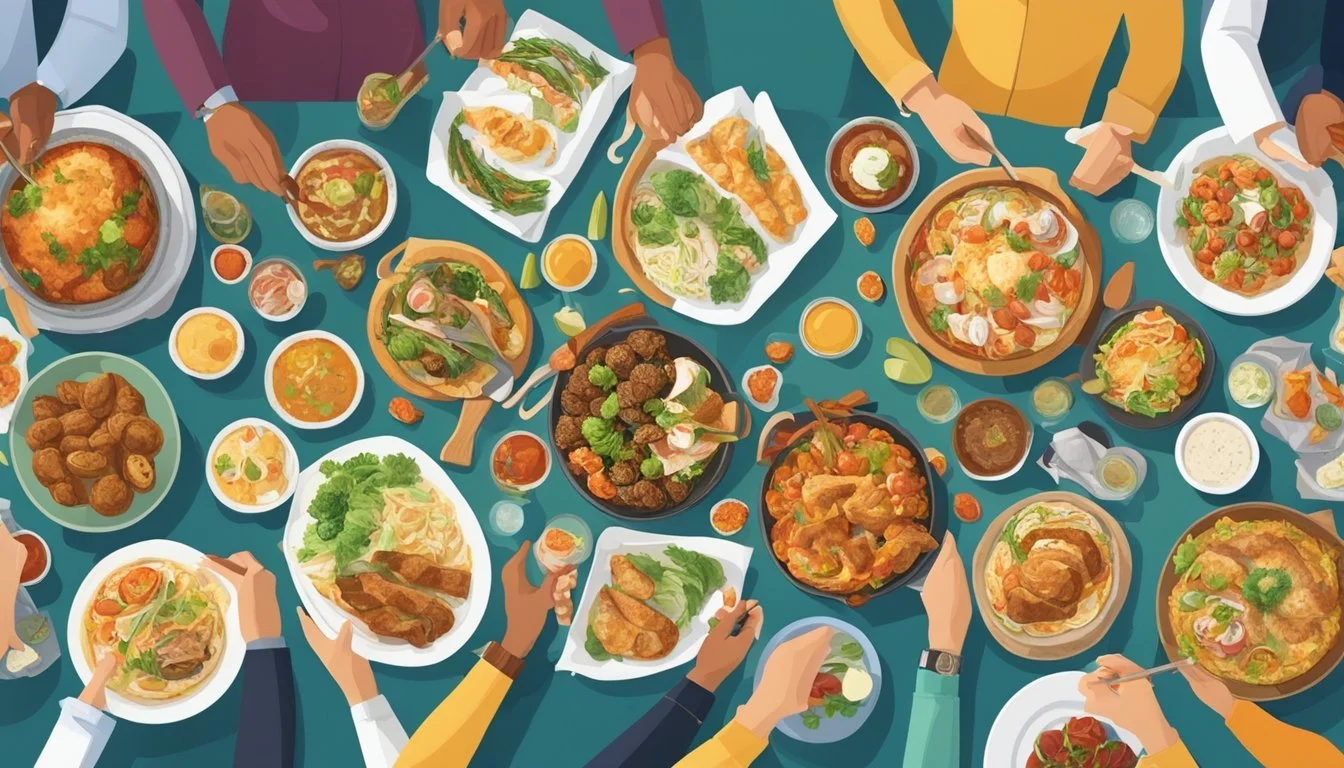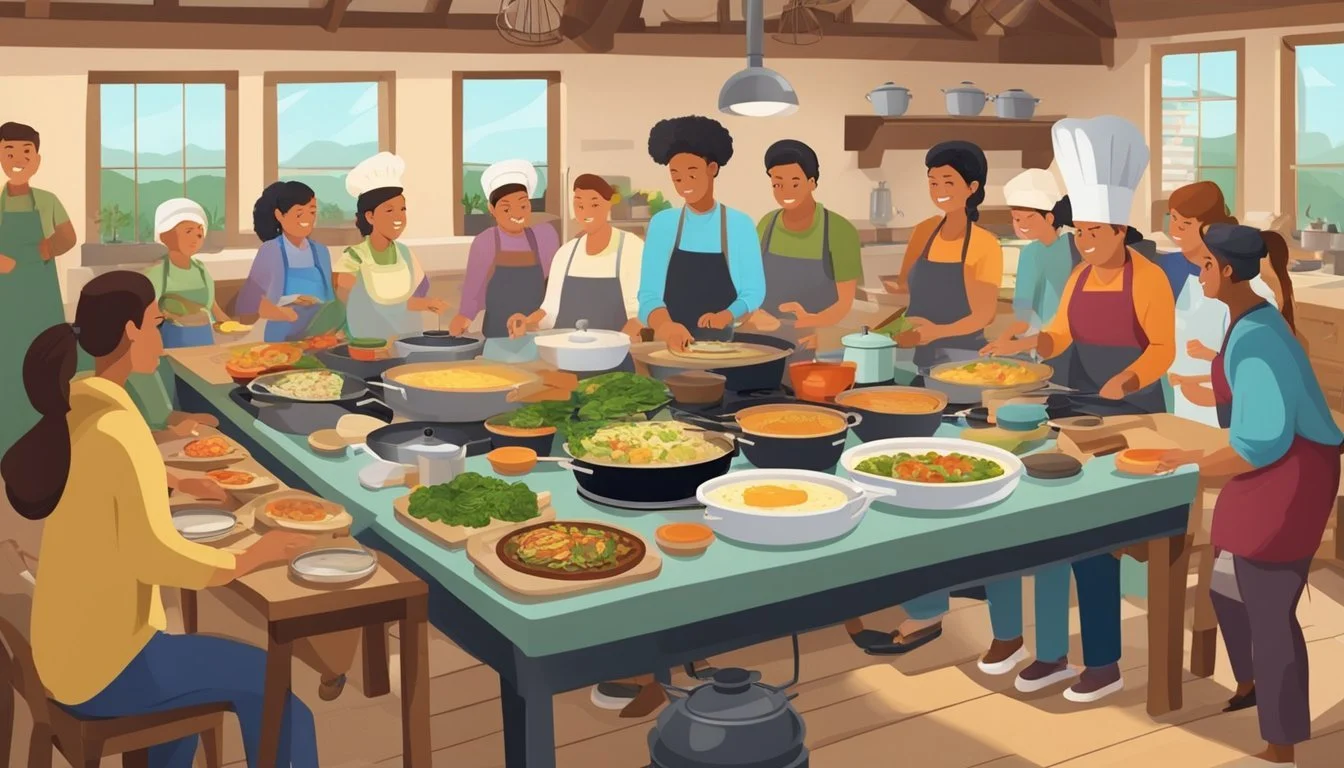How to Cook When You're Hosting a Large Group
Efficient Strategies for Feeding a Crowd
Cooking for a large group presents unique challenges that differ from preparing a meal for a few individuals. A chef hosting a sizable gathering must consider not only the quantity of food required but also the dietary preferences and potential food allergies of the attendees. Efficiency in planning, cooking, and serving becomes crucial to ensure that every guest enjoys their meal without the host feeling overwhelmed.
An effective strategy is crucial for cooking for a larger crowd. This often involves selecting recipes that scale well, ensuring that all ingredients are available in sufficient quantities, and that there is a clear plan for preparation. Temperature control is important too, with cooked meats needing to reach their safe minimum internal temperatures—145ºF for pork, beef, and other red meats; 160ºF for ground meats; and 165ºF for poultry.
Additionally, the versatility of dishes plays an essential role. Casseroles, for example, are popular choices as they can be made ahead of time, freeing up the host to focus on other aspects of the event. Dishes that cater to a variety of tastes and dietary restrictions will also be appreciated by guests, ensuring that nobody is left out. Whether it's a birthday, a holiday, or a simple gathering, meticulous planning and smart menu selection make it possible to host a large group with confidence and ease.
Planning Your Menu
When hosting a large group, selecting a menu requires thoughtful consideration of your guests' preferences, any dietary restrictions, and your ability to prepare and serve dishes efficiently. Choosing the right recipes and balancing flavors are key to a successful meal.
Choosing the Right Recipes
The selection of recipes is the foundation of meal planning. It's essential to consider several factors such as the number of guests, the style of the event, and kitchen limitations. It's wise to choose dishes that can be made in large quantities and possibly prepared ahead of time. For instance:
Appetizers: (What wine goes well with appetizers?) Simple and easy to serve, such as cheese platters or vegetable dips.
Entrées: Dishes that scale well, like lasagnas or casserole-style meals.
Desserts: Choose options like sheet cakes or fruit salads that don't require individual plating.
Additionally, one must keep in mind the budget. Certain ingredients can be costly when multiplied to serve many, so economical choices that still provide flavor and appeal are crucial.
Balancing Flavors and Dietary Restrictions
A successful menu not only tastes good but also caters to the diverse dietary needs of the guests. When planning:
Inquire about dietary restrictions and preferences in advance.
Incorporate a variety of dishes that include:
Vegetarian options, like vegetable sides or main courses.
Gluten-free or other allergy-sensitive alternatives.
Ensure a balanced offering by including:
A mix of light and hearty dishes.
A variety of textures and flavors to satisfy different palates.
By respecting dietary preferences and restrictions, hosts convey a sense of inclusion and consideration, contributing to the overall peace and enjoyment of the meal.
Preparation Strategies
When hosting a large group, cooking success depends on efficient preparation and organization. Chefs recommend precise planning, which includes selecting recipes that can be made ahead and organizing the cooking process to avoid last-minute hassles.
Make-Ahead Tips
Preparing dishes ahead of time is crucial when cooking for a crowd. Chefs suggest that one should focus on recipes that will maintain their quality when stored. Here are some make-ahead tips:
Cold Appetizers and Salads: They can be prepared hours before serving and refrigerated. Examples include pasta salads, potato salad, and cold dips.
Sauces and Marinades: These often taste better when the flavors meld over time. Prepare these the day before and refrigerate.
Desserts: Many desserts, like pies and cakes, can be baked days in advance and kept refrigerated or at room temperature.
Breakfast Bakes: For morning events, casseroles or French toast bakes can be assembled the night before and baked the next day.
Organizing Your Cooking Process
An organized cooking process ensures efficiency and minimizes stress. Here's how to keep the process streamlined:
Scheduling and Timelines: Outline what can be cooked when, starting with the longest to prepare dishes to the quickest ones.
Ingredient Preparation: Pre-chop, measure, and arrange ingredients in the order they will be used. This is referred to as mise en place.
Cookware and Tools Readiness: Have all the pots, pans, utensils, and serving dishes clean and ready to go.
Station Setup: Designate areas for prep, cooking, and serving. Label serving dishes with the intended dish to be placed inside, ensuring a smooth transition to the serving stage.
Cooking Equipment and Space Management
When hosting large groups, efficient use of cooking equipment and space management becomes pivotal. Proper planning can ensure dishes are prepared on time and the available space is used to its maximum potential.
Maximizing Oven Usage
The oven is a critical asset when cooking for large groups, and one must utilize it strategically. To optimize oven space:
Plan Oven Schedules: Chart out cooking times and temperatures for various dishes to avoid conflicts and ensure a smooth workflow.
Use Racks Wisely: Adjust oven racks to fit multiple dishes or use baking sheets and oven-safe pots to stack items.
Setting Up an Efficient Workspace
An organized kitchen space directly contributes to the effectiveness of meal preparation. For setting up an efficient workspace:
Clear & Define Areas: Designate specific zones for prepping, cooking, and serving. Keep these areas clear of clutter.
Arrange Tools Conveniently: Place utensils, cutting boards, and mixing bowls within reach to streamline the cooking process.
By focusing on these strategies, one can handle the demands of cooking for a large group with ease.
Serving a Large Group
When hosting a large group, one must consider the logistics of food service and the presentation that will best accommodate the number of guests. The aim is to provide a seamless experience for everyone involved with minimal wait times and maximum enjoyment.
Buffet-Style Setup
A buffet-style setup is an effective method for serving large gatherings. The host should organize the buffet flow logically:
Start with plates and cutlery, allowing guests to help themselves without any hold-ups.
Salads and appetizers come first, often lighter and less prone to cause congestion.
Main courses follow, spaced evenly to avoid crowding.
Hot dishes should have warming trays or chafing dishes to maintain temperature.
Labels are crucial for each dish to assist guests in making quick decisions.
To manage leftovers effectively, have containers on hand for easy packing and storage. It's advisable to encourage guests to take food home, minimizing wastage.
Choice of Serveware
The selection of serveware is key in a buffet setup. Here are essentials to consider:
Chafing Dishes: Keeps food warm throughout the event, ensuring quality and safety.
Serving Utensils: Ladles for sauces, tongs for salads, and serving spoons for sides.
Plates and Silverware: Sturdy, preferably compostable options if disposables are used. Having a separate area for used dishes can streamline the process.
Always account for a few extra servings than the estimated headcount to avoid running short. The host's foresight in serveware choice can greatly impact the overall success of a party buffet.
Beverages and Accompaniments
When hosting a large group, selecting the right beverages can set the tone of the event, while a variety of snacks can complement the drinks and encourage conversation among guests.
Selecting Wines and Punches
When it comes to wine, one should be mindful of pairing it with the meal's flavors. An array of options from full-bodied red wines like Cabernet Sauvignon to crisp white wines like Sauvignon Blanc ensures there’s something for every palate. For non-alcoholic options, punches offer a refreshing and communal way to enjoy a drink. Here's a basic guide on selecting wines and punches:
Type Option Serving Tip Red Wine Cabernet Sauvignon, Merlot Serve at room temperature; pair with red meats or strong-flavored cheeses. White Wine Chardonnay, Sauvignon Blanc Chill before serving; complement with seafood or light pasta dishes. Rosé Wine Pinot Noir Rosé, Syrah Rosé Ideal for warmer weather; versatile for various dishes. Punch Fruit Punch, Lemonade Punch Serve in a large bowl; garnish with fresh fruits for a festive touch.
Planning For Snacks and Conversation Starters
Offering a selection of snacks not only satisfies hunger but also serves as conversation starters. Opt for an assortment that ranges from light and healthy to the more indulgent. Items like a charcuterie board with fine cheeses and cured meats (What wine goes well with cured meats?), and finger foods like bruschetta and stuffed mushrooms encourage guests to mingle. Consider these tips for snacks:
Healthy options: Vegetable sticks with hummus, fruit skewers
Savory snacks: Mini quiches, (What wine goes well with quiche?) sliders, artisanal bread with dips
Sweet treats: Petite fours, chocolate truffles (What wine goes well with truffles?)
Setting up snack stations can prompt guests to move around and engage with one another, keeping the conversation flowing throughout the evening.
Specialty Dishes and Themes
When hosting a large group, selecting dishes that cater to the occasion and dietary preferences can elevate the experience. Offering a blend of traditional holiday recipes, creative themed party dishes, and vegetarian or fruit-inspired options ensures there's something delightful for every guest.
Holiday Favorites
Thanksgiving, a time for gratitude and family, often features turkey as the centerpiece with a variety of casseroles—each adding a comforting touch to the feast. Classic examples include:
Green Bean Casserole: A creamy dish with mushrooms and crispy fried onions.
Sweet Potato Casserole: Enriched with a touch of cinnamon and a marshmallow topping.
For desserts, one might serve pies ranging from pumpkin to apple, all invoking the warmth of the season.
Themed Party Dishes
A Themed Party calls for dishes that reflect the essence of the concept. Sample themes and corresponding dishes could be:
Cinco de Mayo: Fish Tacos using economical white fish (What wine goes well with white fish?) pair with vibrant salsas and fresh lime.
Weekend Brunch: A spread can include quiches and make-ahead French toast bakes, allowing for a relaxed morning.
Incorporating a theme can make the event more memorable and tailored to guest interests.
Vegetarian and Fruit-Inspired Options
Vegetarian dishes not only cater to those with meat-free diets but can also provide refreshing alternatives for all guests. Dishes could include:
Stuffed Bell Peppers (What wine goes well with stuffed bell peppers?): Filled with quinoa, beans, and spices for a hearty meal.
Cream Cheese (how long does cream cheese last?) and spinach stuffed mushrooms: A savory and luxurious appetizer.
For a lighter fare, fruit platters or fruit-based desserts (What wine goes well with fruit-based desserts?) such as a peach cobbler can be a sweet yet healthier ending to a meal.
Creative Desserts
When hosting a large group, one must consider desserts that cater to various tastes while being feasible to prepare and serve. The goal is to provide options that are both delightful and convenient for guests to enjoy.
Dessert Variety
Dessert variety is essential for satisfying the preferences of a large group. It's wise to include a mixture of flavors and textures. For instance, a classic Apple Slab Pie with its flaky crust and sweet filling can satisfy the crowd's desire for a comforting, fruit-based option. Desserts with cream cheese like cheesecake bars or cream cheese brownies are another versatile choice that can offer a rich, indulgent taste.
Type Dessert Suggestion Base Ingredient Fruit-Based Apple Slab Pie Apples Rich & Creamy Cream Cheese Brownies Cream Cheese
Furthermore, incorporating lighter options such as an angel food cake adorned with fresh fruit and a touch of whipped cream can provide a refreshing counterpoint to rich desserts.
Individual Desserts and Shareable Options
Offering individual desserts can greatly simplify serving and ensure portion control. Personalized treats like mini trifles or parfaits allow guests to grab and go as they mingle. Using clear cups to layer these desserts not only makes them portable but also visually appealing, showcasing the colorful layers of cake, cream, and fruit.
For shareable options, consider large-format desserts that are easy to slice and serve. Sheet cakes, dessert bars, and cookie trays enable guests to take as much or as little as they want. Preparing a peanut butter cookie tray, which requires only a few ingredients like peanut butter, sugar, and eggs, can yield a high quantity of simple, delectable treats suitable for any large gathering.
Format Dessert Example Key Ingredient Individual Mini Fruit Parfaits Fruit Shareable Peanut Butter Cookies Peanut Butter
Catering to the Crowd
When hosting a large group, the chef must balance the preparation of ample food while managing the potential for leftovers and gathering feedback for future events.
Dealing with Leftovers
After the event, a chef might find themselves with more food than the guests could consume. Strategy is crucial in managing leftovers. To maintain food safety and reduce waste, one must quickly cool perishable items. Portioning and labeling the leftovers facilitate ease of distribution. They can offer containers for guests to take food home, or plan for a charitable donation to a local shelter, ensuring no excess goes to waste.
Incorporating Feedback for Improvement
Continuous improvement in catering is essential. Chefs should actively seek feedback during and after the party to refine their offerings. This can be through informal conversations or a feedback form. Key points for inquiry are the quality and quantity of food, as well as the variety of the menu. By incorporating the guest's insights, chefs can adjust their planning for future events, ensuring better satisfaction and minimal leftovers.
Regional Dishes
When hosting a large group, offering regional dishes adds a memorable touch to the dining experience. These dishes can showcase local ingredients and culinary traditions that reflect the region's culture.
Incorporating Local Flavors
When planning a menu, one should consider using ingredients and recipes that highlight the region's specialties. In regions renowned for their cheeses, for example, mac and cheese can be a comforting and familiar dish that still feels special with local artisanal cheeses integrated into the recipe. Similarly, a high-quality dip that utilizes a region's signature produce or spices can provide an easy and delicious way for guests to start their meal.
Hosting in the Pacific Northwest
In the Pacific Northwest, particularly in cities like Portland, the emphasis is often on fresh, locally-sourced ingredients. A Pacific Northwest menu might feature seafood, such as salmon, which could be served as a main dish infused with regional herbs and flavors.
Mac and Cheese: To cater to the Pacific Northwest palate, consider enhancing traditional mac and cheese with local ingredients such as smoked salmon or Dungeness crab (how long does crab last?), garnished with a sprig of fresh dill.
Stuffing: A stuffing dish can be adapted to feature ingredients like wild mushrooms and hazelnuts, providing a unique twist to the classic recipe that guests may expect at a gathering.
For both dishes, not only do they incorporate iconic ingredients from the region, but they also add a level of sophistication to the meal that aligns with the expectations of a group gathering.
Efficient Cleanup Techniques
Effective cleanup strategies after hosting a large group focus on organization and preservation of leftovers. Here's how to tackle post-party cleanups and manage leftovers efficiently.
Post-Party Cleanup
One should begin by collecting all the dishes and sorting them into categories: glassware, cutlery, plates, and cooking utensils. Utilize prep containers to keep used items organized. Soiled dishes should be soaked immediately to simplify washing later, and clear counters of any food waste or debris to maintain order.
For large gatherings, it's practical to have a trash bag and recycling bin accessible to guests, which reduces the number of items left scattered around the space. Assigning different cleaning tasks to volunteers eases the process, with some washing dishes, others wiping surfaces, and a team to sweep and mop floors.
Storage and Preservation of Leftovers
Once the dishes are cleared, attention should turn to managing leftovers. Leftovers should be assessed quickly to determine what can be safely stored and what should be discarded. Edibles that can be preserved need to be placed in airtight containers and labelled with the date. A best practice is to:
Cool the leftovers promptly to avoid bacterial growth.
Divide large quantities of food into smaller portions for faster cooling and easier storage.
Refrigerate or freeze items depending on how soon they will be consumed.
Having a clear system for organizing the refrigerator or freezer is vital. One might group similar items together and place what needs to be consumed soonest at the front. This practice not only keeps leftovers organized but also minimizes waste by ensuring that they are not forgotten.
Interactive Cooking
When hosting a large group, interactive cooking can transform meal preparation into an engaging event. This approach allows guests to participate in the cooking process, fosters conversation, and enhances the overall party experience.
Engaging Guests with Cooking Activities
Interactive cooking activities should be planned with the guests’ enjoyment in mind. They offer an opportunity for individuals to learn new recipes and techniques, while also socializing and being part of the culinary action. Organizers can set up cooking stations where guests can try their hand at various tasks, from assembling ingredients to the actual cooking, all under the guidance of a host or a professional chef.
It is crucial to have a well-thought-out plan for the cooking activities to ensure a smooth experience:
Preparation: Provide guests with a list of ingredients and equipment needed for the interactive session.
Demonstration: Offer a quick tutorial demonstrating the steps and techniques they will be utilizing.
Participation: Encourage guests to dive into the preparation and cooking processes.
Safety: Make sure everyone understands how to handle kitchen tools and appliances safely to prevent accidents.
Using these activities as a part of the event can also be a conversation starter, as guests can discuss what they're making, exchange tips, and share personal cooking stories. This not only creates a lively environment but also strengthens relationships among guests. An interactive cooking party can be a memorable experience that combines the joy of eating with the pleasure of learning and socializing.







